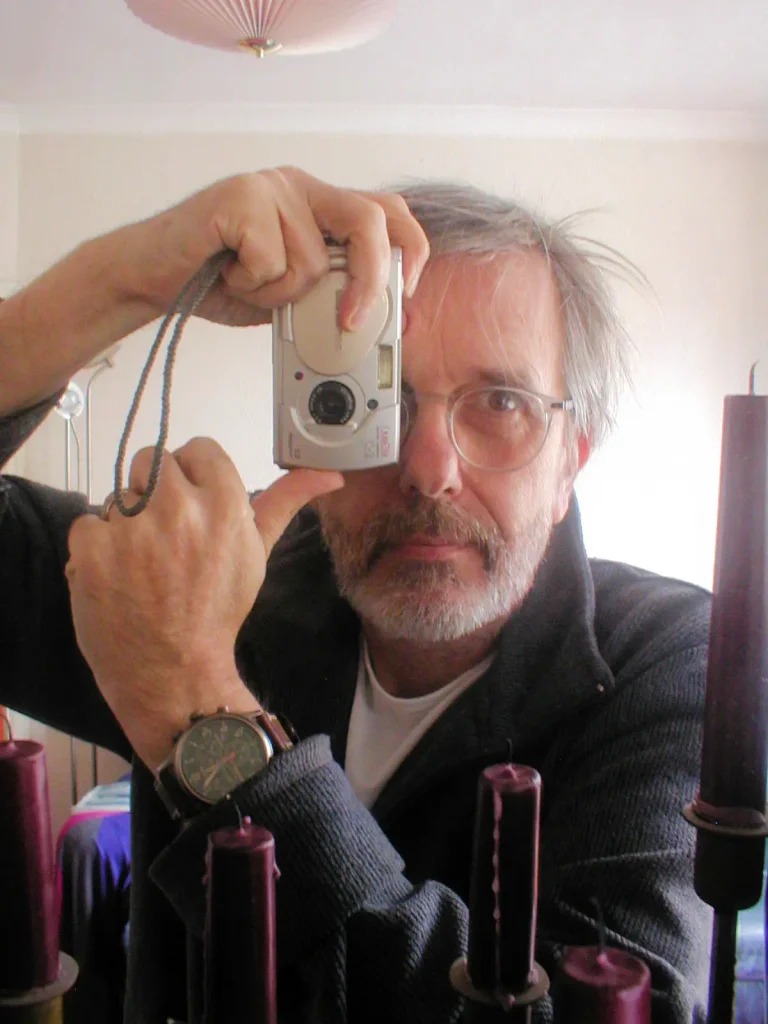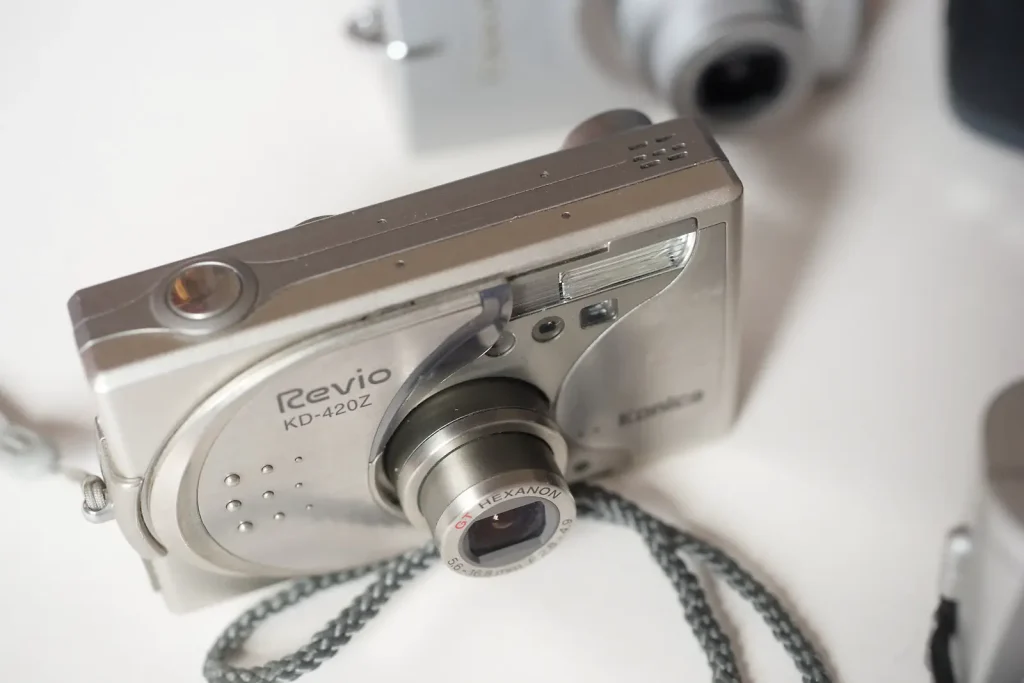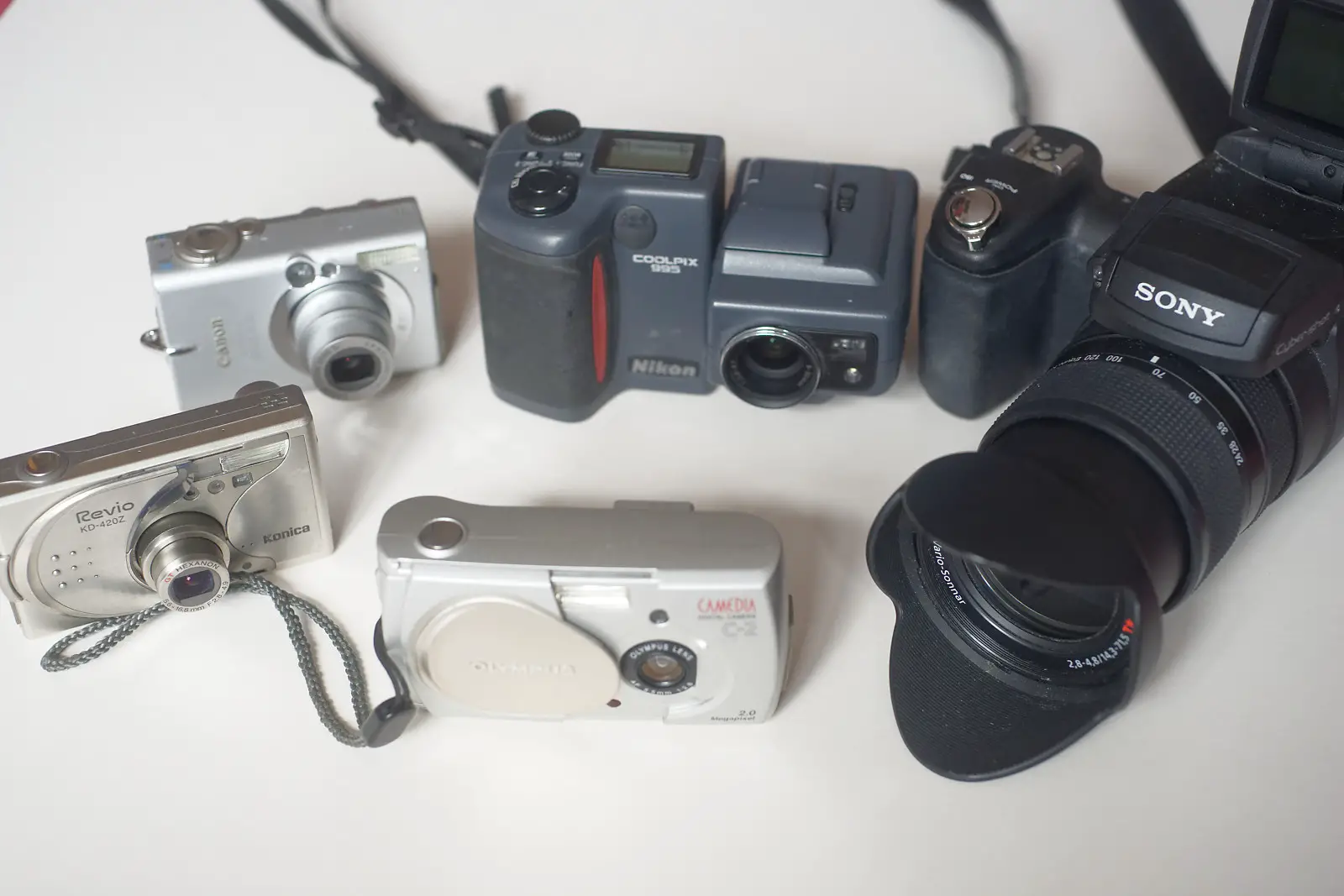The world spins. Everything comes around. Eventually we start to get misty-eyed about stuff that seems to have only just left the room. Yes, I’m at that point. I’m about to get nostalgic about digital cameras.
There was a sort of proto age of digital cameras at the start of the millennium, just before DSLRs started to dominate. Back then, digital cameras were possibly at their most varied and most innovative.
Nostalgia got me back into photography
My own insertion into digital photography started with a family history project. I raided the family albums to assemble the images that went with the names I was uncovering. I looked back into the eyes of people I’d heard tales of, some of whose DNA I shared, but would never meet.
My initial copies were taken on black and white film using my old Konica Autoreflex T3. The copies were not as clear as the originals, but they could be shared – and they were preserved.
Later in the 90s I had access to a portable PC and a scanner. The process was easier than photographic copies and the results were very good. I limited myself to 1MB for those first scans, because it seemed practical to make sure that even the biggest files would fit on a 3.5 inch floppy disk.

I reached the stage where I was taking current photographs of the family and scanning the prints. Once affordable digital cameras became available which could match a 6×4 print, it seemed there was a process that could be cut out.
From documenting the growth of our boys and key family events, I slipped back into my old ‘arty’ ways (what my mother, looking through my photographs when I was a teen, referred to as ‘More rusty metal..’)
Twenty years have passed since then. I find I’ve got a small but interesting collection of a type of camera that had a brief hayday between 2001 and 2005.
Nikon Coolpix 995 (2001)
This was a serious camera. The whole series took a fresh look at the ergonomics of cameras. The body was in two parts, with a swivel connector. The zoom mechanism was contained within the body without making the body too bulky, while the screen could be positioned to be easily visible for awkward shots from low or high angles.

The camera was aimed at serious photographers, offering as much creative control as was possible with a small sensor. The Coolpix 995 had a 3.34MP sensor (resolution was precious – no-one ignored the numbers after the decimal point back then). RAW files were written to a Compact-Flash card.

Sample shots



Olympus C-2 (2001)
The C-2 was my first digital camera. It featured a fixed focal length lens, a sliding front cover and a 2MP sensor. This was a reasonable compromise for me. My father had spent the previous decade being asked by friends and family to repair their power-zoom compacts. He had little regard for the robustness of such devices, so a fixed-lens camera was no turn-off to me.

Other plusses were that the C-2 ran off two AA batteries (although conventional alkaline batteries didn’t last long). The camera offered an interesting panorama function with supplied stitching software. It used Smartmedia cards, which are not easy to get hold of these days. The format didn’t last much beyond this date. Olympus and Fujifilm (the main users) switched to the new XD card (which also didn’t last long).
Sample shots


Canon IXUS 400 (2003)
This was my late father-in-law’s camera. It is a lovely example of the tiny jewel-like IXUS/IXY/ELPH concept which combined function and design to produce a practical small digital camera that had style. The concept outlived the analogue format (APS) that it was originally designed for. Highlights were the use of CompactFlash cards, a 4MP sensor and a three-times zoom lens that was reasonably fast at the wide end.

Sample shots
Now, with electronics this old, there was bound to be a at least one casualty. The IXUS seems to have gone a bit abstract.


Minolta Dimage G400 (2004)
Mergers and acquisitions
Minolta did lots of innovative stuff in the early days of digital. They made some great and very affordable film scanners, they made serious bridge cameras, clever folded-optics zoom cameras and even pioneered In Body Image Stabilization (IBIS), which they called Anti-Shake (AS). They were also involved in a merger with Konica, oldest of all the Japanese photographic companies. Konica had a respectable reputation as a camera manufacturer, but were bigger in film and film processing and particularly promising in business machines.

Identity crisis
This particular camera was originally a Dimage G400 which I bought for my middle son. As teenagers do, he took it to the beach and introduced it to sand – not a great idea with a camera that has a sliding cover and bits that get clogged up. I replaced it with something a little more environmentally sealed (a folded zoom camera from Olympus) and found a broken donor camera on the internet that I could steal the metal outer case from. That was when this particular camera changed identity from a Minolta to a Konica.
In truth it was a Konica all along. Even the Minolta-branded versions still sported Konica’s Hexanon lens. The camera itself is neat, with the 3x zoom protected by a metal sliding cover. This makes it safer to slip in a pocket without the risk of the zoom trying to deploy if the ‘on’ button is accidentally pressed – a danger I had foreseen in teen use, although I reckoned without the sand.
Creative controls are there, but not very easy to select. Of particular note, is that the camera had dual memory card slots, being able to take an SD card or the original format of the Sony memory-stick.
Sample shots



Sony Cyber-Shot DSC-R1 (2005)
A last gasp of these dinosaur cameras. The R1 featured a 10MP APS-C sized CMOS sensor (CMOS had tended to be Canon’s domain up until this point). It gave a live view of the sensor via an electronic viewfinder and featured a fully articulating LCD screen on top of the camera. This could be viewed from behind, in front or above to compose. It could even be turned to face inwards to protect the screen if it was not required for composition or menus. Because it uses a leaf shutter, the R1 can synch with electronic flash up to the maximum 1/2000. I’m not at all sure how it manages 1/2000 with a leaf shutter, but it does seem to work.

Dual CompactFlash and Memory-stick card slots are available, but you choose between them, rather than them being able to be used together.
All the creative controls you would need are supported, with Aperture priority, Shutter priority, program and manual exposure being available, along with choice of focus point. It had a nice manual zoom ring. The manual focus ring is fly-by-wire, but with a wonderful smooth feel.
Critical and commercial response
The lens was the big selling point. A Carl Zeiss branded Vario-Sonnar with T* coatings. It was a ‘fast-at-the-wide-end-and-not-too-shabby-at-the-long-end’ 4x zoom. Most of the reviews at the time commented that the camera was worth the price for the lens alone.

Reviewers were pleased with the results, but not enamoured with the EVF or the positioning of the rear/top screen. The camera took great photos, the lens was lovely and the sensor was good for its day – but writing a RAW file to the card took several seconds. It is possible to take a burst of three shots in a one-second burst, but you are limited to JPG and you have to wait some time before it writes those to the card. It might have sold better if it had been able to exploit video capabilities, but the early sensor got too hot to handle video. As it was, this camera was a pedestrian in a world filling with automobiles.
The R1 lost out to DSLRs that featured similarly sized (although slightly lower resolution) sensors. The kit lenses of the DSLRs were not to the same standard as the Vario-Sonnar, but interchangeable lenses offered more flexibility over time. The public voted with their wallets.
Sony soon had other things to concentrate on. Their own DSLR plans had to be brought forward when Konica Minolta quit photography for copiers. There was never an R2. Sony did return to large-sensor bridge cameras, but mostly those were with a smaller 1” sensor and zooms of colossal range.
Sample shots



Conclusion

Just 4 years separates the two cameras that bookend this selection, but progress in that time was huge.
The Coolpix 995 is a great camera, still very usable today. But it sports a 1/1.8” sensor which is less than 1/10 the size of the R1’s APS-C (ish) sensor. Resolution also tripled. The R1’s zoom ‘equivalent’ starts at 24 mm in comparison to the 995’s 38 mm. These were years of almost runaway progress, but all these innovative cameras would be swept away by a DSLR tide.
Cameras either reverted to the standard box-and-lens format of analogue days, or retired into a smartphone flat slab. The days of the wierd, wonderful and exotic slid away.
None of these cameras is really practical any more, although I might use the R1 occasionally if I need a top-quality zoom or some fill flash. After nearly 20 years it is not just the poor old IXUS that shows its age. As internal batteries give up the ghost, cameras that used to remember you had disabled the flash, forget that and the date. These were marvels in their time, but now they are just a reminder that our current kit is far more advanced.
Share this post:









Comments
Robart on Digital Nostalgia – 5 Early Digital Cameras from between 2001 and 2005 – By Bob Janes
Comment posted: 22/03/2022
Comment posted: 22/03/2022
Lee on Digital Nostalgia – 5 Early Digital Cameras from between 2001 and 2005 – By Bob Janes
Comment posted: 22/03/2022
Comment posted: 22/03/2022
Randy Keeler on Digital Nostalgia – 5 Early Digital Cameras from between 2001 and 2005 – By Bob Janes
Comment posted: 22/03/2022
Comment posted: 22/03/2022
Alex G on Digital Nostalgia – 5 Early Digital Cameras from between 2001 and 2005 – By Bob Janes
Comment posted: 22/03/2022
I can sympathize with the fact that people are looking for fun cheap alternatives to film point and shoots. It’s hard to find one these days in working condition for under 3 figures. And current color film prices including developing and scanning make each shot cost .80 cents to a dollar, that sucks also.
But you can get a working Konica Auto Reflex with lens for $30, bulk load b/w film, and it’s still about as cheap as it ever was…
Kurt Ingham on Digital Nostalgia – 5 Early Digital Cameras from between 2001 and 2005 – By Bob Janes
Comment posted: 22/03/2022
Terry B on Digital Nostalgia – 5 Early Digital Cameras from between 2001 and 2005 – By Bob Janes
Comment posted: 22/03/2022
Comment posted: 22/03/2022
Comment posted: 22/03/2022
Comment posted: 22/03/2022
C.A.Johnson on Digital Nostalgia – 5 Early Digital Cameras from between 2001 and 2005 – By Bob Janes
Comment posted: 23/03/2022
As noted the lens was quite special. I prefer wide angle compositions so the extra width was always appreciated. Couple with the larger APS sensor, the images were really good (for the time). More recently, the latest software tools can really enhance imagery from this vintage digital camera.
It also had its limitations- grainy screen, sluggish autofocus, slow file writing, odd menu, limited features compared to the latest mirrorless units. But, as with most photographers who know their tools, it took a bit of skill to work within its limitations. The results were rarely disappointing. I still take it with me on occasion today for its unique attributes.
Jay Dann Walker in Melbourne on Digital Nostalgia – 5 Early Digital Cameras from between 2001 and 2005 – By Bob Janes
Comment posted: 29/03/2022
Digital photography was stuck far too long in the unmemorable 5.1 MB era, back about 2004-5 everyone and their cat seemed to have one of these. Horrible A4 prints, soft in the edges, dark in the corners. Largely due to this best-forgotten time, I resisted moving into digital until Canon and Nikon upped the stakes by moving into 10 MB territory with the 450D and the D90, both of which I bought - and still own the latter, which my partner uses nowadays for around-home snaps of our cats and the garden.
Of the lot, the Sony is probably still the Best Buy, and usable today. The rest reside in the dinosaurs graveyard...
Interesting to note that the Canon and Nikons I owned (this takes me back to 2009 and 2011, respectively) are still eminently more usable today, bearing in mind that my current Nikons, D700s and D800s, are also regarded by many gear heads as living antiques. Also my Nikkormats FT2s and Nikon F65 kits, and my darkroom in the guest bedroom, but those are not digital, so I'll say no more.
Of the aforementioned Sony, one of our local charity shops had one donated about 18 months ago. They priced it at AUD$100 and it sat gathering dust in a locked cabinet for over a year, the price came down to $50, then $40. We used to make bad jokes about it - "does it come complete with the original crank to start it with??" and suchlike. Eventually, finally, someone put it out of its misery and took it home, reputedly for $25. It probably ended up on Bay for $500 "or best offer" as such relics do.
This written from someone who still has his original IBM PC from 1985 - I won't tell you what that contraption cos the to buy new, it still embarrasses me even after almost 40 years - with boxes of 5-inch floppy disks and the box of software disks and the ten kilograms of instruction manuals it came with. Booting up the thing with a Windows floppy was enough to drive anyone to drink. I've not turned the thing on for many years but I reckon if I did then it would fire up immediately, like all those old relics of the Early Digital Age.
Of course all this makes me realise that I too am a relic, a living one, and my turn on Ebay may yet come, if I overstep the boundaries of my film photography at home and my partner decides to 'cull' me, as the Aussies and Kiwis do to their sheep...
And those D90s, D700s and D800s will have their day as historical period pieces too. Trust me on this.
Written tongue-in-cheek. Kudos to the author for a most enjoyable article. Looking forward to more.
From Dann in Melbourne
Comment posted: 29/03/2022
Comment posted: 29/03/2022
Comment posted: 29/03/2022
Gary on Digital Nostalgia – 5 Early Digital Cameras from between 2001 and 2005 – By Bob Janes
Comment posted: 01/04/2022
Rob Smith on Digital Nostalgia – 5 Early Digital Cameras from between 2001 and 2005 – By Bob Janes
Comment posted: 25/10/2022
I use my R1 (and F828) for landscape work,given their high quality lenses too.
I've no need for mega expensive mirrorles bodies and lenses.
Appreciating the Camera - M P Osborne on Digital Nostalgia – 5 Early Digital Cameras from between 2001 and 2005 – By Bob Janes
Comment posted: 18/02/2023
Rowan Hazel on Digital Nostalgia – 5 Early Digital Cameras from between 2001 and 2005 – By Bob Janes
Comment posted: 10/09/2023
It had its frustrations like slow startup, an interminable shutter delay, & very poor battery life, yet it made the most beautiful pictures. Pictures are noiseless at ISO 50 & even ones at ISO 400 have a lovely film grain effect. The lens was fantastic.
Sadly, I killed it in a cycling accident after a couple of years. I felt the newer Ixuses were not as good & I moved onto other brands. But no compact digital camera I’ve had since has equalled its results.